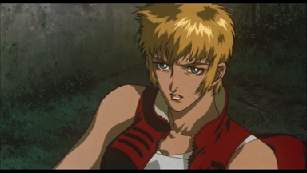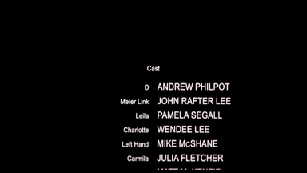Vampire Hunter D: Bloodlust (2000)
Too good, also true.
My attention span is on life support. Over twenty years of cellphone use has conditioned my brain to panic after seven seconds of silence. I’m 40 now, but if I’m standing in a long line at the store, I scroll through my phone like a caffeinated primary schooler.
This acute fear of boredom has ruined my old pastimes. ‘Marathoning’ TV shows? Unless it’s a special event, forget about it; I’m lucky to make it through through three episodes. Movies are easier, but with weekends being so finite and fleeting, a 90 minute running time flares up my anxiety something awful.
The same thing happens whenever I watch modern anime. I miss how fun anime used to be to sit through. I remember consuming an entire shelf of numbered tape volumes, eating pizza bagels, swallowing a Pepsi in one gulp, and watching the tapes again. But when it comes to newer anime, it starts with how much flatter and brighter, blegh, digital animation looks compared to when it was hand drawn.
Other times, Ill stopped paying attention so much, I’ll get too lost to backtrack. I abandoned High School DxD because of this.
No, I’m not kidding.
Watching Vampire Hunter D: Bloodlust seemed somehow predestined. Although it was a big event in my circle 25 years ago, I spent those last 25 years not watching it. Then I discovered Bloodlust Blu-ray copies were still being printed, and I decided I’d waited long enough.
Bloodlust is the sequel to the 1985 Vampire Hunter D, which I have no trouble throwing into the DVD player. The slightest nostalgic rose tint filter obscures it, however. My teenage self loved it because it had blood and tits, unlike all our American Hanna-Barbera reruns. There was that scene where the mutant’s head exploded; that was after Doris took her obligatory shower.
‘85 D’s biggest issue was it had that weird pacing problem of old anime, where entire establishing scenes are missing. It’s like when I’m watching Captain Harlock, and suddenly Daiba is engaged in dogfights outside the spaceship. In the case of ‘85 D, Doris stands in front of the Count’s throne as if she teleported there. Dan sneaks into the castle without explaining how it was even possible. Stuff just happens. Jesus, slow down.
But everything the original did wrong, Bloodlust improves upon. Moreover, it reawakened my love of both anime and movies in general, giving me a reason to no longer fear devoting my time to either.
The movie takes place in a post-post nuclear apocalypse world, where human civilization has reverted a cyperpunk/Victorian Weird West. The vampires, who once rose from the irradiated shadows to enslave humanity, are now dying as the humans make a comeback.
The titular D is a Dhampir (pronounced dun-peel). In the event you don’t speak Nerd, a dhampir is a half-human/half-vampire hybrid, created when a human and vampire intimately settle their differences. Society treats Dhampirs as outcasts, forcing them to pick one race or the other. D kills vampires for money, embracing his human half while betraying the other. This means humans still hate him, and he doesn’t have much hope of hanging out with the bloodsuckers, either.
D travels the world accompanied by his Left Hand. Not the kind from Resident Evil 4; a face, credited as D’s Left Hand, lives in D’s left hand. In the first movie, Hand was more pleasant to look at, and he sounded like a higher-pitched Rob Paulsen type character. In Bloodlust, he looks pained and grimaced.
He’s also voiced by Michael McShane this time, a prolific character actor, who I nevertheless only recognized as the dead hypnotherapist from Office Space. Now he talks with an old smoker’s throat. Aside from acting as D’s invisible door detector or evil spell swallower, Hand is the movie’s comic relief and equal parts D’s conscience and verbal abuser. Hand is kind of an Asshole.
A Vampire named Meier Link has stolen away a village girl named Charlotte in the dead of night. Her father and brother hire D to save her. The younger son is a belligerent nosferatu-ist blowhard, while the dad is a little more reasonable. Nevertheless, the latter informs D he’s already contracted the Marcus Brothers, a bounty hunter group. Now it will be a race to see who finishes the job first.
Marcus is their last name. They aren’t all named Marcus. The moment they make their entrance, the competition appears to be decided. D still rides his classic cyborg horse, but the brothers drive A Fucking Tank. They also cross the fantasy/sci-fi boundary by bringing cybernetic tech to monster fights.
Each Marcus has his own monster slaughtering superpower, but they all pale in comparison to Grove. Grove, otherwise deathly ill, can astral project his soul when he’s injected with some unexplained drug. His true potential is as an archangel that wields the power of blinding, creature obliterating badassery.
Riding along with them is Leila, who is not a Marcus sister, but just an woman, hanging out with a buncha dudes. She is on a cold-hearted, lifelong quest to kill vampires for the murder of her family. Spiteful toward D at first, Leila warms up to him as the story continues They form a platonic, comrades in arms sort of thing. Leila relates to D’s loneliness, and it puts her on a path to rediscovering the ability to forgive, feel, and love again.
Now, I’m not going to bullshit you people, either. I just re-read the last sentence in that previous paragraph, and it sounded like thematic purple prose. While that is the nature of D and Leila’s relationship, I’ve been sitting on this review too long to revise anything else.
However, I noticed something else during a rewatch. Leila doesn’t do much to help out during the movie. Although she maintains a tough front, she ends up in trouble whenever she tries to fight. “The ability to forgive, feel, and love again” implies one of two things. The movie is either saying “revenge is bad and kills you early,” or “maybe Leila ought to quit this ‘strong woman’ stuff and start a family like a proper female, amirite?” But it’s not my business to criticize Japan about its cultural mores. I’m trying to write a review about a vampire killing anime film.
Meanwhile, the subplots keep stacking up. Meier Link has hired a monster clan called the Barbaroy to protect his carriage. Their powers are even more impressive than the ones from Ninja Scroll, like a shapeshifter who can turn any physical matter into a weapon, and a demon that murders the shit out of people with its liquid shadow.
Then everyone discovers a twist in the hunt, that Charlotte is in love with Meier Link. The job is stopping an elopement, not a kidnapping. It creates a great sense of moral ambiguity. The whole movie is like that, gray tinted ethics shadowing everything.
Even D falls under scrutiny, as his lifestyle brings up interesting questions. By killing his own kind for money, aiding in their extinction, he is also killing a part of himself.
Before I put my new Vampire Hunter D: Bloodlust Blu-ray into the player, I used a coin flipping app to determine which language track to pick for a first time viewing. Heads would’ve been dub, tails sub. The result was tails, so subs it would be.
Except there was no Japanese subtitled version on the disc. I checked the case to see if I was reading my screen right. Sure enough, there was no mistake. Now, this was odd, as dual language tracks have been a thing since the now ancient DVD days.
Doing the appropriate research, I discovered this is a rare instance where the studio recorded an English track first. A Japanese language version is out there somewhere, but it’s supplemental enough that excluding it doesn’t make a difference.
The voice actors do a decent job, though. The cast includes several well-knowns. Pamela Adlon, Bobby Hill herself, supplies Leila’s voice. Veteran Wendee Lee voices Charlotte. John DiMaggio, no surprise, has a half-dozen roles. What did surprise me, though, was Maurice LaMarche’s absence, as man is omnipresent in every animated project.
As for D himself, a VA named Andrew Philpot plays him. He does a good job, too He voices D like Michael McConnohie played him in the original—soft-spoken, monotonic, and emotionless. Urban Vision didn’t decide he was British, Scottish, or Romanian, and thank God for that.
By the movie’s halfway mark, the entire story has involved everybody chasing a horse carriage. But not a moment of it is boring. More importantly, there’s always something going on, whether it’s an action sequence or a quiet moment. The quiet parts are equal in scope and impact to the action parts.
Bloodlust is beautifully drawn and animated, too, rivaling anything released during the Disney Renaissance. Every frame displays care and consideration for the project. I forgot anime could look this good.
According to what the Google AI bot just vomited up from a search, “Vampire Hunter D: Bloodlust (2000) was one of the last anime films of its era to heavily rely on hand-drawn animation rather than digital techniques.” I had to make sure I wasn’t talking out of my ass; research is important. But yes, I am so used to how lifeless digital animation looks in modern anime. Computers are evil. AI is worse. Fuck all the adherence to our new digital masters. Returning to my point, though: this movie is very pretty.
Vampire Hunter D: Bloodlust is a damned good movie. It should have sent seismic waves through anime as a whole. Fans of the medium should bring it up as much as Studio Ghibli’s work, and I’m shocked I never see it talked about in wherever I lurk. It’s the best ADHD treatment I’ve encountered in a long time.
Final Grade: ****

